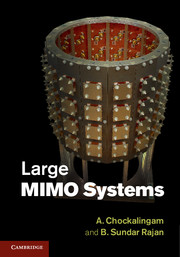Book contents
- Frontmatter
- Dedication
- Contents
- Preface
- Acknowledgments
- Abbreviations
- Notation
- 1 Introduction
- 2 Large MIMO systems
- 3 MIMO encoding
- 4 MIMO detection
- 5 Detection based on local search
- 6 Detection based on probabilistic data association (PDA)
- 7 Detection/decoding based on message passing on graphical models
- 8 Detection based on MCMC techniques
- 9 Channel estimation in large MIMO systems
- 10 Precoding in large MIMO systems
- 11 MIMO channel models
- 12 Large MIMO testbeds
- Author index
- Subject index
- References
11 - MIMO channel models
Published online by Cambridge University Press: 18 December 2013
- Frontmatter
- Dedication
- Contents
- Preface
- Acknowledgments
- Abbreviations
- Notation
- 1 Introduction
- 2 Large MIMO systems
- 3 MIMO encoding
- 4 MIMO detection
- 5 Detection based on local search
- 6 Detection based on probabilistic data association (PDA)
- 7 Detection/decoding based on message passing on graphical models
- 8 Detection based on MCMC techniques
- 9 Channel estimation in large MIMO systems
- 10 Precoding in large MIMO systems
- 11 MIMO channel models
- 12 Large MIMO testbeds
- Author index
- Subject index
- References
Summary
Channel models play a crucial role in the design and analysis of wireless communication systems. They enable the system designers to analyze the performance of wireless systems and optimize design parameters even before the systems are actually built. They are key ingredients in such design and performance evaluation exercises, which are often carried out through mathematical analysis or computer simulation or a combination of both. A good channel model that accurately captures the real channel behavior is a very valuable tool that can accelerate the development of practical wireless systems. The need for good channel models to aid the design, analysis, and development of MIMO systems in general, and large MIMO systems in particular, is immense. A lot of effort has been directed towards MIMO channel sounding campaigns and MIMO channel modeling. Measurements from these campaigns have aided the formulation of MIMO channel models in wireless standards [1]–[4]. Channel sounding campaigns with large numbers of antennas, in both outdoor and indoor settings, have also appeared, though sparsely, in the literature. Now, with the increasing interest in large MIMO system implementations, there is renewed interest and activity in large MIMO channel sounding. While these channel measurements are expected to yield accurate and realistic models for large MIMO channels, the traditional analytical MIMO channel models which are widely known in the literature, are expected to find continued use.
Information
- Type
- Chapter
- Information
- Large MIMO Systems , pp. 251 - 284Publisher: Cambridge University PressPrint publication year: 2014
